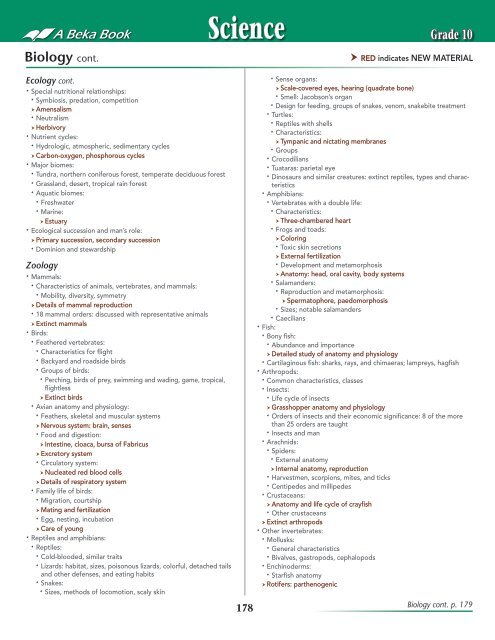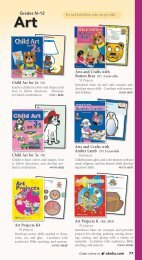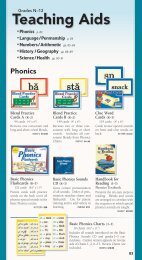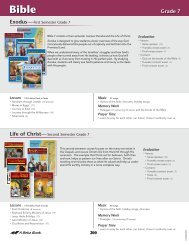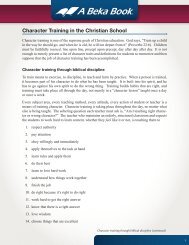Science & Health - A Beka Book
Science & Health - A Beka Book
Science & Health - A Beka Book
You also want an ePaper? Increase the reach of your titles
YUMPU automatically turns print PDFs into web optimized ePapers that Google loves.
Biology cont.<br />
Ecology cont.<br />
• Special nutritional relationships:<br />
• Symbiosis, predation, competition<br />
h Amensalism<br />
• Neutralism<br />
h Herbivory<br />
• Nutrient cycles:<br />
• Hydrologic, atmospheric, sedimentary cycles<br />
h Carbon-oxygen, phosphorous cycles<br />
• Major biomes:<br />
• Tundra, northern coniferous forest, temperate deciduous forest<br />
• Grassland, desert, tropical rain forest<br />
• Aquatic biomes:<br />
• Freshwater<br />
• Marine:<br />
h Estuary<br />
• Ecological succession and man’s role:<br />
h Primary succession, secondary succession<br />
• Dominion and stewardship<br />
Zoology<br />
• Mammals:<br />
• Characteristics of animals, vertebrates, and mammals:<br />
• Mobility, diversity, symmetry<br />
h Details of mammal reproduction<br />
• 18 mammal orders: discussed with representative animals<br />
h Extinct mammals<br />
• Birds:<br />
• Feathered vertebrates:<br />
• Characteristics for flight<br />
• Backyard and roadside birds<br />
• Groups of birds:<br />
• Perching, birds of prey, swimming and wading, game, tropical,<br />
flightless<br />
h Extinct birds<br />
• Avian anatomy and physiology:<br />
• Feathers, skeletal and muscular systems<br />
h Nervous system: brain, senses<br />
• Food and digestion:<br />
h Intestine, cloaca, bursa of Fabricus<br />
h Excretory system<br />
• Circulatory system:<br />
h Nucleated red blood cells<br />
h Details of respiratory system<br />
• Family life of birds:<br />
• Migration, courtship<br />
h Mating and fertilization<br />
• Egg, nesting, incubation<br />
h Care of young<br />
• Reptiles and amphibians:<br />
• Reptiles:<br />
• Cold-blooded, similar traits<br />
• Lizards: habitat, sizes, poisonous lizards, colorful, detached tails<br />
and other defenses, and eating habits<br />
• Snakes:<br />
• Sizes, methods of locomotion, scaly skin<br />
<strong>Science</strong><br />
178<br />
• Sense organs:<br />
Grade 10<br />
h red indicates NeW MATerIAL<br />
h Scale-covered eyes, hearing (quadrate bone)<br />
• Smell: Jacobson’s organ<br />
• Design for feeding, groups of snakes, venom, snakebite treatment<br />
• Turtles:<br />
• Reptiles with shells<br />
• Characteristics:<br />
h Tympanic and nictating membranes<br />
• Groups<br />
• Crocodilians<br />
• Tuataras: parietal eye<br />
• Dinosaurs and similar creatures: extinct reptiles, types and characteristics<br />
• Amphibians:<br />
• Vertebrates with a double life:<br />
• Characteristics:<br />
h Three-chambered heart<br />
• Frogs and toads:<br />
h Coloring<br />
• Toxic skin secretions<br />
h External fertilization<br />
• Development and metamorphosis<br />
h Anatomy: head, oral cavity, body systems<br />
• Salamanders:<br />
• Reproduction and metamorphosis:<br />
h Spermatophore, paedomorphosis<br />
• Sizes; notable salamanders<br />
• Caecilians<br />
• Fish:<br />
• Bony fish:<br />
• Abundance and importance<br />
h Detailed study of anatomy and physiology<br />
• Cartilaginous fish: sharks, rays, and chimaeras; lampreys, hagfish<br />
• Arthropods:<br />
• Common characteristics, classes<br />
• Insects:<br />
• Life cycle of insects<br />
h Grasshopper anatomy and physiology<br />
• Orders of insects and their economic significance: 8 of the more<br />
than 25 orders are taught<br />
• Insects and man<br />
• Arachnids:<br />
• Spiders:<br />
• External anatomy<br />
h Internal anatomy, reproduction<br />
• Harvestmen, scorpions, mites, and ticks<br />
• Centipedes and millipedes<br />
• Crustaceans:<br />
h Anatomy and life cycle of crayfish<br />
• Other crustaceans<br />
h Extinct arthropods<br />
• Other invertebrates:<br />
• Mollusks:<br />
• General characteristics<br />
• Bivalves, gastropods, cephalopods<br />
• Enchinoderms:<br />
• Starfish anatomy<br />
h Rotifers: parthenogenic<br />
Biology cont. p. 179


